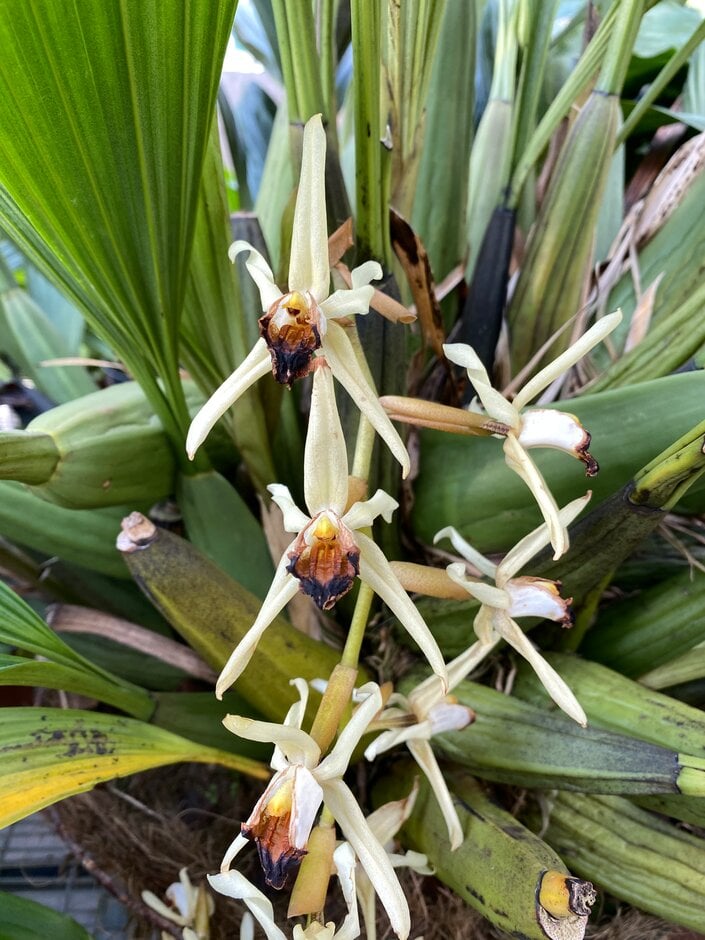Coelogyne Brymeriana gx
A large-sized, epiphytic orchid up to 1m tall and wide, producing a clump pseudobulbs, which serve as storage organs for water and nutrients. Each cylindrical pseudobulb is 25-30cm tall and carries a pair of stiff, dark-green, lange-shaped leaves. Each leaf measures 5-10cm wide and up to 70cm long. The orchid usually flowers in spring on 45-70cm long, pendulous stems. Each stem carries 15 to 60 pale-cream, sometime yellow-green flowers. Star-shaped, 4cm large flowers have pale petals and sepals with medium to dark-brown markings on a lip. This orchid is considered a "primary hybrid" because it is a cross of two species

Size
Ultimate height
0.5–1 metresTime to ultimate height
5–10 yearsUltimate spread
0.5–1 metresGrowing conditions
Moisture
Moist but well–drained, Well–drainedpH
NeutralColour & scent
| Stem | Flower | Foliage | Fruit | |
| Spring | Brown Cream Green White | Green | ||
|---|---|---|---|---|
| Summer | Green | |||
| Autumn | Green | |||
| Winter | Green |
Position
- Partial shade
Aspect
East–facing or North–facing or South–facing or West–facing
Exposure
Sheltered Hardiness
H1ABotanical details
- Family
- Orchidaceae
- Native to GB / Ireland
- No
- Foliage
- Evergreen
- Habit
- Clump forming, Pendulous weeping
- Genus
Coelogyne are epiphytic orchids producing pseudobulbs, each bearing 2 leathery pleated leaves and flowers in racemes, mainly from the centre of the new growth in spring and summer
- Name status
Accepted
How to grow
Cultivation
Grow in an open, free-draining, bark-based orchid mix. Provide enough bright filtered light, but keep away from direct sunlight or a heating source. Ideal temperatures are around 16 °C minimum at night and up to 28 °C during the day. Water regularly, when the pot feels light when lifted. Ensure that all water drains away, preventing the plant from sitting wet. Orchid fertiliser can be applied regularly throughout the growing season. Reduce watering and feeding in winter months. The orchid will naturally produce rhizomes with aerial roots growing outside the pot. As with many orchids, they grow best when well-established and slightly pot-bound. Re-potting should be only done if the plant overgrows its container or before the potting mix starts to deteriorate - approximately once in 2-3 years. See indoor orchid cultivation for more tips
Propagation
Propagation by seed is only possible in a controlled laboratory environment. Well-established plants can be propagated by division. Ensure each division has young enough, mature pseudobulbs to support new growth
Suggested planting locations and garden types
- Houseplants
- Conservatory and greenhouse
Pruning
No pruning required other than removing spent flower stems
Pests
May be susceptible to scale insect and mealybugs. Thrips can cause damage on flowers and developing flower buds
Diseases
Generally disease-free. Poor air movement may cause bacterial or fungal rots. Good hygiene practice and sterilising cutting tools prevent the spread of virus diseases
Get involved
The Royal Horticultural Society is the UK’s leading gardening charity. We aim to enrich everyone’s life through plants, and make the UK a greener and more beautiful place.